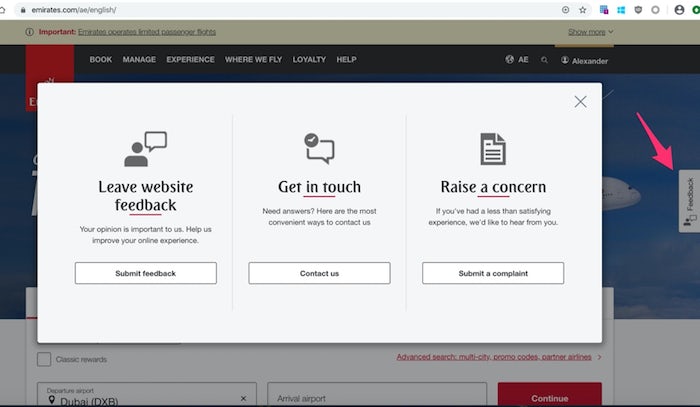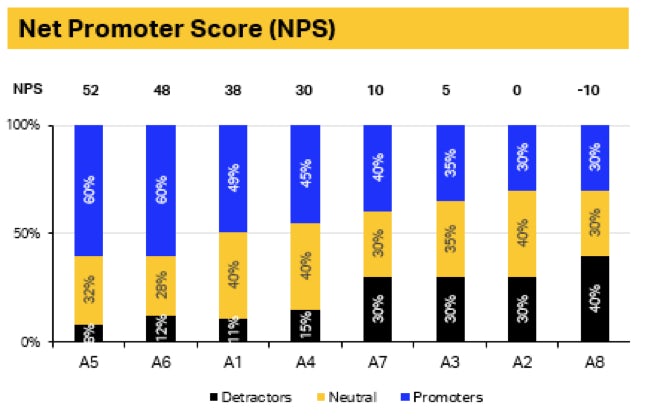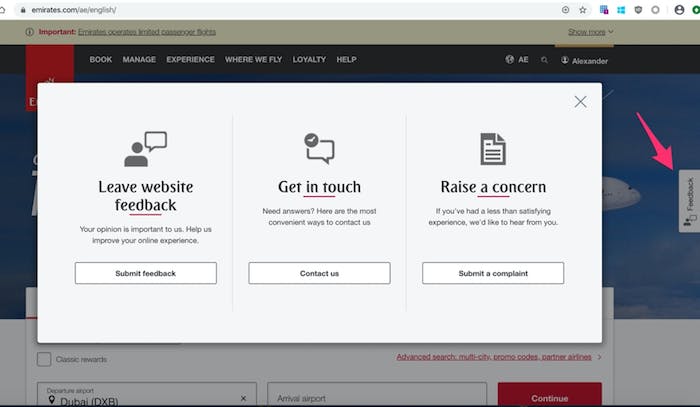Covid-19 has forced most consumers worldwide to change their habits and behaviors and to rely on online solutions for things usually done face to face. Brands that are providing their customers with easy, enjoyable and seamless online experiences during the crisis are likely to benefit from these forced behavior changes post COVID-19.
If you want to understand how well your brand is doing in providing your customers with a high-quality and fully satisfactory experience across all of your digital touch points, you can apply some or all of the following 10 practical techniques. I have included specific examples of how we at Emirates apply them and the impact we have seen from them on our customer metrics.
1) Create an online ‘Voice of Customer’ program
Create an online ‘Voice of Customer’ program to capture feedback from your customers who are using your digital channels.
Include a ‘feedback’ button on all key pages:

Customer feedback options. Image: Emirates.com
Furthermore, prompt pro-actively for feedback after customers carried out key tasks online to understand their satisfaction with each of these tasks.
Customer engagement with short and simple surveys tends to be high. At Emirates we receive 100-150K completed surveys per quarter and derive a lot of insights from them which helps prioritize our product backlogs. Our average rating over the past three quarters has been ±4.2 out of 5.
2) Measure the speed of your website
In particular for 3G and 4G connection and benchmark it against global leaders, such as airbnb.com, amazon.com, alibaba.com, booking.com, expedia.com, etc. as well as against your competitors.
3) Analyze your app ratings
Analyze your app ratings on Google Play, iOS App Store and Huawei App Gallery, benchmark your average app rating versus your competitors and determine the key root causes for receiving 1-star and 2-star ratings from your app users.
- We use appbot to receive a daily update on our app reviews.
- We also respond to many users who take the effort to rate and review our app.
4) Leverage usability research & usability analytics
Leverage usability research (remote and/or on-site) and usability analytics to understand needs and preferences of customers using your digital channels and incorporate them into your development cycle. Create prototypes of new proposed features and run them by real users and customers before deciding to move forward with them.
- We have been working with UK-based User Vision for many years on on-site usability testing in different geographies and can recommend them.
- For remote user testing, we use UserZoom, which is a very useful and cost-effective platform.
- We recently implemented Quantum Metric as our main UX analytics tool and it is a powerful platform, which uncovers opportunities to improve online user experiences at scale through machine learning.
5) Look for external industry studies and surveys
Look for external industry studies and surveys that measure customer satisfaction for your brand and for your key competitors.
We use the Airsat Passenger Satisfaction Benchmark program delivered by the International Air Transport Association (IATA) and a travel market research agency M1nd-set to measure customer satisfaction across 20 major airlines in Europe, the Middle East and Asia. With important Key Performance Indicators (eg NPS) and detailed travel attributes, the survey helps monitor our competitive position throughout the entire customer experience, including our website.

Net Promoter Score, IATA Airsat Passenger Satisfaction Benchmark, selected airlines, mock data
6) Benchmark your online experience using The Bowen Craggs Index
Benchmark your online experience with leading global brands from a customer, a jobseeker, a journalist and a society perspective against global best practices using The Bowen Craggs Index of Online Excellence, a credible benchmark of a firm’s online corporate communication across website, mobile, social media, app compared to other global companies.
In our latest review, Emirates jumped in the global Bowen Craggs Index of Online Excellence from position 128th to position 66th, one of the largest increases Bowen Craggs has ever observed. Some companies Emirates now ranks higher than are Facebook, FedEx, Boeing, Pepsi, Apple, Samsung, L’Oréal, P&G, BT and Disney. Emirates is the only airline who participates in the index and our aim is to be in the Top30 global brands that lead this Index.
In addition to the ranking, every participating firm receive a detailed report with suggested usability improvements.
7) Measure through A/B testing and pre- and post-change analytics
Measure the impact of all key changes to your online experiences through A/B testing and pre- and post-change analytics.
At Emirates we have a dedicated conversion rate optimization (CRO) program in place, which collects and A/B tests ideas to improve our transactional online booking process. To design this program, we worked with an external consultant (ex booking.com) to ensure we follow global best practices.
In addition to our CRO program, we conduct A/B tests to optimize the experience for users across a wide spectrum of features (site log-in, registration to our Loyalty program Skywards, Help & Contact us pages, etc).
8) Use a digital quality management tool
Use a digital quality management tool (DQM) to crawl your site for broken links, which lead customers to 404 error pages as well as to spot issues with your content across all languages you support. Integrated directly into your web content management solution, you can easily identify, prioritize, and fix errors across all your digital properties.
At Emirates we use Crownpeak Digital Quality Management (DQM) and can recommend the tool.
9) Work with your regional Marketing teams to optimize landing pages
Work with your regional Marketing teams and key Marketing partners who drive significant traffic to your website, to review and optimize landing pages based on Analytics data. Look into high bounce rates from specific Marketing traffic sources as they often indicate user experiences, which can be improved.
We created an automated dashboard with key metrics for all landing pages. We also set up automated alerts to be aware if a metric goes outside the defined variance.
10) Analyze customer feedback captured via your call centre and Customer Care teams
Analyze customer feedback captured via your call centre and Customer Care teams, via your virtual assistant (if available) as well as via customer satisfaction surveys
- Your call centre agents receive direct feedback from your customers what they don’t like about their experience(s) with your brand. Leverage this feedback to understand and address common customer pain points.
- Customer complaints can also be a good source of insight, although the volume tends to be smaller as only very disgruntled customers take the effort to submit a formal complaint.
In addition, ensure your employees spend time on your website, your mobile site, your mobile app and your social media channels to experience the true customer experience. Often employees use internal tools and are not familiar enough with the online channels of their own brand.
The quality of your digital and physical customer experiences have a significant impact on how consumers rate your brand. So, take advantage of the current slower pace in business to improve your foundations and listen and analyze closely what your customers tell you.
Focus on ‘getting the basics right’ for your key online experiences as a priority before investing in innovative features for niche audiences or for PR purposes. Evolution tends to be more successful than revolution.
This article was originally published by the author on LinkedIn.







